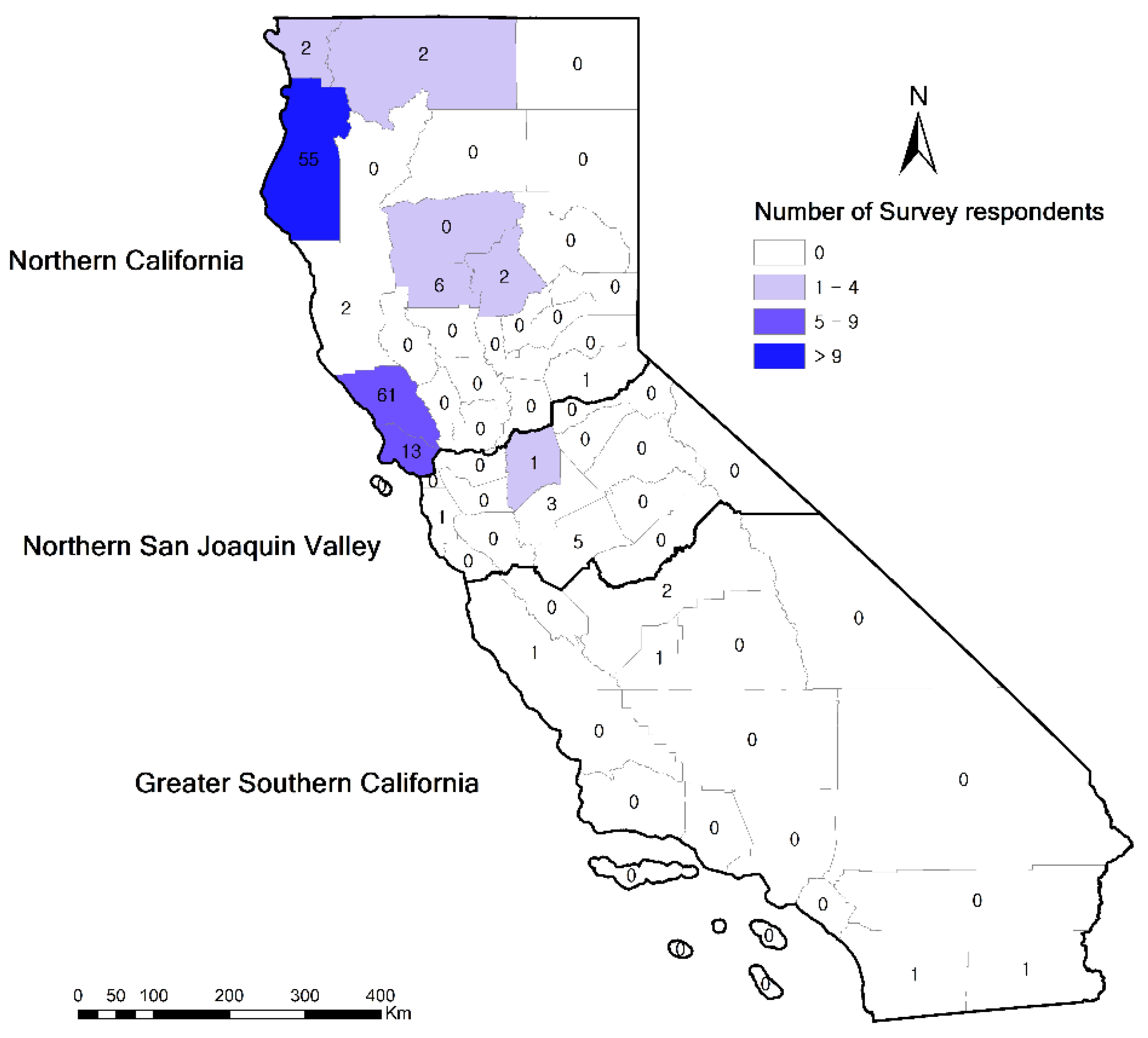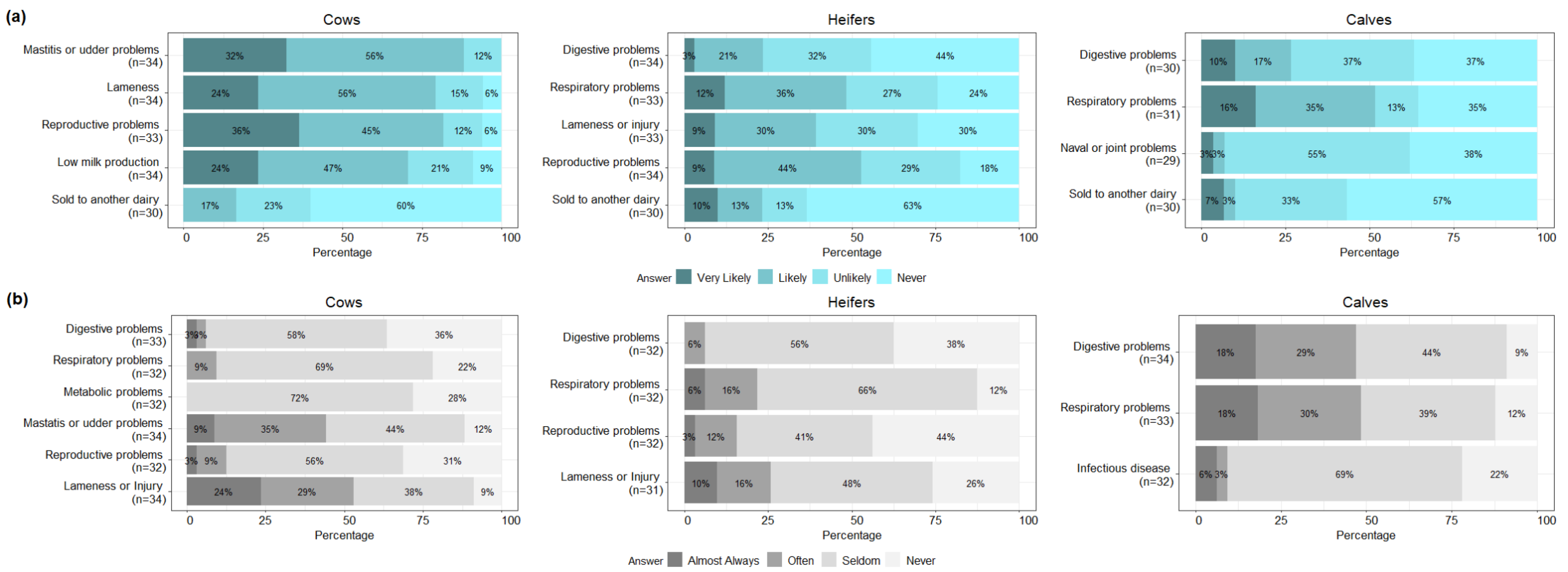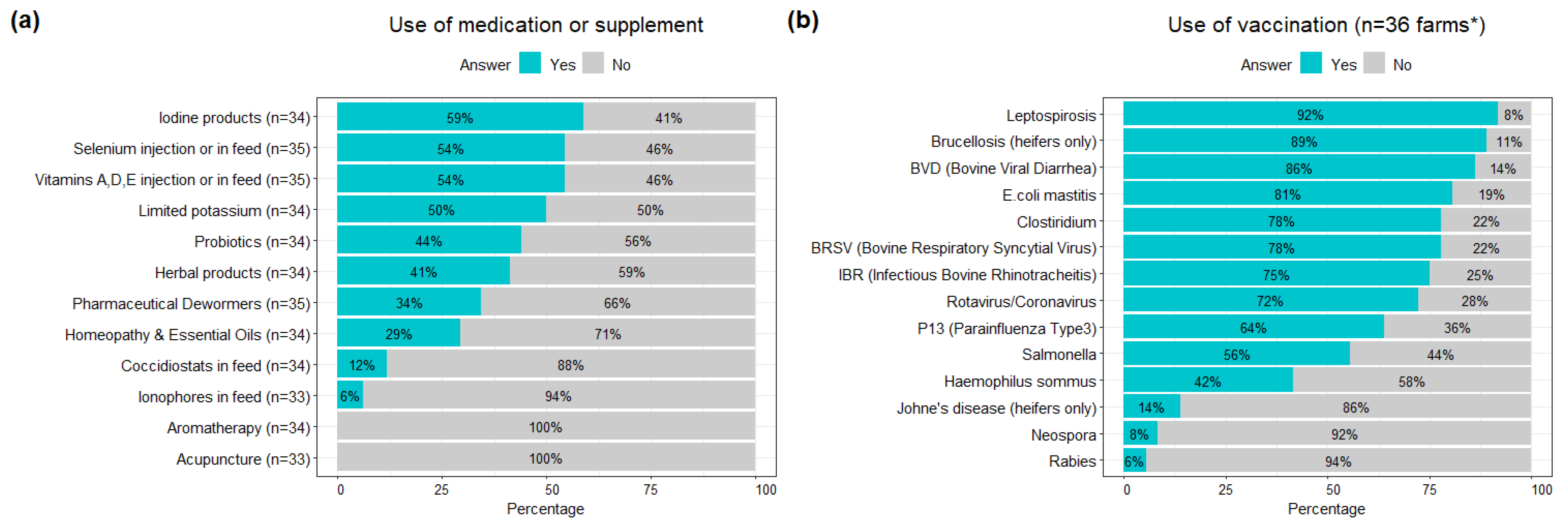Survey of Management Practices and Farmers’ Perceptions of Diseases on Organic Dairy Cattle Farms in California
Abstract
Simple Summary
Abstract
1. Introduction
2. Materials and Methods
2.1. Participant Recruitment and Survey Administration
2.2. Survey Questionnaires
2.3. Data Management and Statistical Analysis
3. Results
3.1. Farm Demographics
3.2. Animal Disease Management
3.3. Parasite-Specific Questions
3.4. Housing and Pasture Management
3.5. Organic Education and Outreach
4. Discussion
5. Conclusions
Supplementary Materials
Author Contributions
Funding
Institutional Review Board Statement
Informed Consent Statement
Data Availability Statement
Acknowledgments
Conflicts of Interest
References
- USDA-NASS. United States Summary and State Data. In 2017 Census of Agriculture; Geographic Area Series; National Agricultural Statistics Service: Washington, DC, USA, 2019; Volume 1, Part 51. [Google Scholar]
- Harris, V. Organic Survey Data Release Executive Briefing. 2019. Available online: https://www.nass.usda.gov/Surveys/Guide_to_NASS_Surveys/Organic_Production/pdf/2019_Organic_Executive_Briefing.pdf (accessed on 22 October 2020).
- Howle, E.M. California Department of Food and Agriculture. In California Agricultural Statistics Review 2019–2020; California Department of Food and Agriculture: Sacramento, CA, USA, 2020; p. 160. [Google Scholar]
- Sorge, U.S.; Moon, R.; Wolff, L.J.; Michels, L.; Schroth, S.; Kelton, D.F.; Heins, B. Management Practices on Organic and Conventional Dairy Herds in Minnesota. J. Dairy Sci. 2016, 99, 3183–3192. [Google Scholar] [CrossRef] [PubMed]
- Harwood, W.S.; Drake, M.A. Identification and Characterization of Fluid Milk Consumer Groups. J. Dairy Sci. 2018, 101, 8860–8874. [Google Scholar] [CrossRef] [PubMed]
- Liu, Z.; Kanter, C.A.; Messer, K.D.; Kaiser, H.M. Identifying Significant Characteristics of Organic Milk Consumers: A CART Analysis of an Artefactual Field Experiment. Appl. Econ. 2013, 45, 3110–3121. [Google Scholar] [CrossRef]
- Carfora, V.; Cavallo, C.; Caso, D.; Del Giudice, T.; De Devitiis, B.; Viscecchia, R.; Nardone, G.; Cicia, G. Explaining Consumer Purchase Behavior for Organic Milk: Including Trust and Green Self-Identity within the Theory of Planned Behavior. Food Qual. Prefer. 2019, 76, 1–9. [Google Scholar] [CrossRef]
- USDA. The Code of Federal Regulation; USDA: Washington, DC, USA, 2004; p. 395.
- Government of Canada. Organic Production Systems: General Principles and Management Standards; Canadian General Standard Board: Ottawa, ON, Canada, 2021. [Google Scholar]
- The European Union Official Journal of the European Union L150, Regulation on Organic Production and Labelling of Organic Products and Repealing Council Regulation No 834/2007 2018.
- Ruegg, P.L. Management of Mastitis on Organic and Conventional Dairy Farms. J. Anim. Sci. 2009, 87, 43–55. [Google Scholar] [CrossRef]
- Stiglbauer, K.E.; Cicconi-Hogan, K.M.; Richert, R.; Schukken, Y.H.; Ruegg, P.L.; Gamroth, M. Assessment of Herd Management on Organic and Conventional Dairy Farms in the United States. J. Dairy Sci. 2013, 96, 1290–1300. [Google Scholar] [CrossRef]
- Zwald, A.G.; Ruegg, P.L.; Kaneene, J.B.; Warnick, L.D.; Wells, S.J.; Fossler, C.; Halbert, L.W. Management Practices and Reported Antimicrobial Usage on Conventional and Organic Dairy Farms. J. Dairy Sci. 2004, 87, 191–201. [Google Scholar] [CrossRef]
- Sorge, U.S.; Moon, R.D.; Stromberg, B.E.; Schroth, S.L.; Michels, L.; Wolff, L.J.; Kelton, D.F.; Heins, B.J. Parasites and Parasite Management Practices of Organic and Conventional Dairy Herds in Minnesota. J. Dairy Sci. 2015, 98, 3143–3151. [Google Scholar] [CrossRef]
- Abdelfattah, E.M.; Ekong, P.S.; Okello, E.; Williams, D.R.; Karle, B.M.; Rowe, J.D.; Marshall, E.S.; Lehenbauer, T.W.; Aly, S.S. 2019 Survey of Antimicrobial Drug Use and Stewardship Practices in Adult Cows on California Dairies: Post Senate Bill 27. Microorganisms 2021, 9, 1507. [Google Scholar] [CrossRef]
- Ekong, P.S.; Abdelfattah, E.M.; Okello, E.; Williams, D.R.; Lehenbauer, T.W.; Karle, B.M.; Rowe, J.D.; Aly, S.S. 2018 Survey of Factors Associated with Antimicrobial Drug Use and Stewardship Practices in Adult Cows on Conventional California Dairies: Immediate Post-Senate Bill 27 Impact. PeerJ 2021, 9, e11596. [Google Scholar] [CrossRef]
- U.S. Department of Health; Human Services Public Health Service; Food and Drug Administration. Grade “A” Pasteurized Milk Ordinance; FDA: Silver Spring, MD, USA, 2019.
- Stern, M.J.; Bilgen, I.; Dillman, D.A. The State of Survey Methodology: Challenges, Dilemmas, and New Frontiers in the Era of the Tailored Design. Field Methods 2014, 26, 284–301. [Google Scholar] [CrossRef]
- Love, W.J.; Lehenbauer, T.W.; Karle, B.M.; Hulbert, L.E.; Anderson, R.J.; Van Eenennaam, A.L.; Farver, T.B.; Aly, S.S. Survey of Management Practices Related to Bovine Respiratory Disease in Preweaned Calves on California Dairies. J. Dairy Sci. 2016, 99, 1483–1494. [Google Scholar] [CrossRef] [PubMed]
- Martins, J.P.N.; Karle, B.M.; Heguy, J.M. Needs Assessment for Cooperative Extension Dairy Programs in California. J. Dairy Sci. 2019, 102, 7597–7607. [Google Scholar] [CrossRef] [PubMed]
- Kuo, H.-J.; Peters, D.J. The Socioeconomic Geography of Organic Agriculture in the United States. Agroecol. Sustain. Food Syst. 2017, 41, 1162–1184. [Google Scholar] [CrossRef][Green Version]
- McBride, W.D.; Greene, C. Characteristics, Costs and Issues for Organic Dairy Farming; USDA: Washington, DC, USA, 2009. [CrossRef]
- Rodrigues, A.C.O.; Caraviello, D.Z.; Ruegg, P.L. Management of Wisconsin Dairy Herds Enrolled in Milk Quality Teams. J. Dairy Sci. 2005, 88, 2660–2671. [Google Scholar] [CrossRef]
- Buckley, F.; Lopez-Villalobos, N.; Heins, B.J. Crossbreeding: Implications for Dairy Cow Fertility and Survival. Animal 2014, 8, 122–133. [Google Scholar] [CrossRef] [PubMed]
- Brock, C.C.; Pempek, J.A.; Jackson-Smith, D.; Weaver, K.; da Costa, L.; Habing, G.G. Organic Dairy Producer Experiences and Decisions Related to Disease Prevention and Treatment. J. Dairy Sci. 2021, 104, 5867–5880. [Google Scholar] [CrossRef]
- Pol, M.; Ruegg, P.L. Treatment Practices and Quantification of Antimicrobial Drug Usage in Conventional and Organic Dairy Farms in Wisconsin. J. Dairy Sci. 2007, 90, 249–261. [Google Scholar] [CrossRef]
- USDA-NASS; USDA-APHIS. Dairy 2014. Health and Management Practices on U.S. Dairy Operations; United States Department of Agriculture: Washington, DC, USA; Center for Epidemiology and Animal Health: Washington, DC, USA, 2018.
- Mushtaq, S.; Shah, A.M.; Shah, A.; Lone, S.A.; Hussain, A.; Hassan, Q.P.; Ali, M.N. Bovine Mastitis: An Appraisal of Its Alternative Herbal Cure. Microb. Pathog. 2018, 114, 357–361. [Google Scholar] [CrossRef]
- Mayer, M.; Vogl, C.R.; Amorena, M.; Hamburger, M.; Walkenhorst, M. Treatment of Organic Livestock with Medicinal Plants: A Systematic Review of European Ethnoveterinary Research. Complement. Med. Res. 2014, 21, 375–386. [Google Scholar] [CrossRef]
- Abaineh, D.; Sintayehu, A. Treatment Trial of Subclinical Mastitis with the Herb Persicaria Senegalense (Polygonaceae). Trop. Anim. Heal. Prod. 2001, 33, 511–519. [Google Scholar] [CrossRef] [PubMed]
- Rainard, P.; Foucras, G. A Critical Appraisal of Probiotics for Mastitis Control. Front. Vet. Sci. 2018, 5, 251. [Google Scholar] [CrossRef] [PubMed]
- Bouchard, D.S.; Seridan, B.; Saraoui, T.; Rault, L.; Germon, P.; Gonzalez-Moreno, C.; Nader-Macias, F.M.E.; Baud, D.; François, P.; Chuat, V.; et al. Lactic Acid Bacteria Isolated from Bovine Mammary Microbiota: Potential Allies against Bovine Mastitis. PLoS ONE 2015, 10, e0144831. [Google Scholar] [CrossRef] [PubMed]
- Francoz, D.; Wellemans, V.; Dupré, J.P.; Roy, J.P.; Labelle, F.; Lacasse, P.; Dufour, S. Invited Review: A Systematic Review and Qualitative Analysis of Treatments Other than Conventional Antimicrobials for Clinical Mastitis in Dairy Cows. J. Dairy Sci. 2017, 100, 7751–7770. [Google Scholar] [CrossRef]
- Nickerson, S.C. Vaccination as a Tool to Control Mastitis in Dairy Cows. Available online: https://secure.caes.uga.edu/extension/publications/files/pdf/B%201501_1.PDF (accessed on 13 December 2021).
- USDA-NASS; USDA-APHIS. Dairy 2014. Milk Quality, Milking Procedures, and Mastitis on U.S. Dairies; United States Department of Agriculture: Washington, DC, USA; Center for Epidemiology and Animal Health: Washington, DC, USA, 2016.
- Gerald, L.S.; James, G.; Brett, T.W.; Neil, D. Pinkeye (Infectious Bovine Keratoconjunctivitis). Available online: https://www.ag.ndsu.edu/publications/livestock/pinkeye-infectious-bovine-keratoconjuctivitis (accessed on 13 December 2021).
- Davidson, H.J.; Stokka, G.L. Pinkeye Infectious Bovine Keratoconjuctivitis. Available online: https://www.coffey.k-state.edu/crops-livestock/livestock/PInkeye.pdf (accessed on 16 December 2021).
- Angelos, J.A. Infectious Bovine Keratoconjunctivitis (Pinkeye). Vet. Clin. N. Am. Food Anim. Pr. 2015, 31, 61–79. [Google Scholar] [CrossRef]
- Hall, R.D. Relationship of the Face Fly (Diptera: Muscidae) to Pinkeye in Cattle: A Review and Synthesis of the Relevant Literature. J. Med. Entomol. 1984, 21, 361–365. [Google Scholar] [CrossRef]
- Steve, P.C.; Lilly, J.H. Investigations on Transmissability of Moraxella Bovis by the Face Fly. J. Med. Entomol. 1965, 58, 444–446. [Google Scholar] [CrossRef]
- O’Connor, A.M.; Angelos, J.A.; Dennis, E.J.; Elizalde, P.; Kneipp, M.; Loy, J.D.; Maier, G. Future Directions for Research in Infectious Bovine Keratoconjunctivitis. Vet. Clin. N. Am. Food Anim. Pract. 2021, 37, 371–379. [Google Scholar] [CrossRef]
- Cho, Y.-i.; Yoon, K.-J. An Overview of Calf Diarrhea—Infectious Etiology, Diagnosis, and Intervention. J. Vet. Sci. 2014, 15, 1–17. [Google Scholar] [CrossRef]
- Heller, M.C.; Chigerwe, M. Diagnosis and Treatment of Infectious Enteritis in Neonatal and Juvenile Ruminants. Vet. Clin. N. Am. Food Anim. Pract. 2018, 34, 101–117. [Google Scholar] [CrossRef]
- Klein-Jöbstl, D.; Iwersen, M.; Drillich, M. Farm Characteristics and Calf Management Practices on Dairy Farms with and without Diarrhea: A Case-Control Study to Investigate Risk Factors for Calf Diarrhea. J. Dairy Sci. 2014, 97, 5110–5119. [Google Scholar] [CrossRef] [PubMed]
- Frank, N.A.; Kaneene, J.B. Management Risk Factors Associated with Calf Diarrhea in Michigan Dairy Herds. J. Dairy Sci. 1993, 76, 1313–1323. [Google Scholar] [CrossRef]
- Cortese, V.S. Neonatal Immunology. Vet. Clin. N. Am. Food Anim. Pr. 2009, 25, 221–227. [Google Scholar] [CrossRef] [PubMed]
- Gorden, P.J.; Plummer, P. Control, Management, and Prevention of Bovine Respiratory Disease in Dairy Calves and Cows. Vet. Clin. N. Am. Food Anim. Pract. 2010, 26, 243–259. [Google Scholar] [CrossRef] [PubMed]
- Maier, G.U.; Love, W.J.; Karle, B.M.; Dubrovsky, S.A.; Williams, D.R.; Champagne, J.D.; Anderson, R.J.; Rowe, J.D.; Lehenbauer, T.W.; Van Eenennaam, A.L.; et al. A Novel Risk Assessment Tool for Bovine Respiratory Disease in Preweaned Dairy Calves. J. Dairy Sci. 2020, 103, 9301–9317. [Google Scholar] [CrossRef]
- Karle, B.M.; Maier, G.U.; Love, W.J.; Dubrovsky, S.A.; Williams, D.R.; Anderson, R.J.; Van Eenennaam, A.L.; Lehenbauer, T.W.; Aly, S.S. Regional Management Practices and Prevalence of Bovine Respiratory Disease in California’s Preweaned Dairy Calves. J. Dairy Sci. 2019, 102, 7583–7596. [Google Scholar] [CrossRef]
- Richert, R.M.; Cicconi, K.M.; Gamroth, M.J.; Schukken, Y.H.; Stiglbauer, K.E.; Ruegg, P.L. Management Factors Associated with Veterinary Usage by Organic and Conventional Dairy Farms. J. Am. Vet. Med Assoc. 2013, 242, 1732–1743. [Google Scholar] [CrossRef]
- Pereira, A.B.D.; Brito, A.F.; Townson, L.L.; Townson, D.H. Assessing the Research and Education Needs of the Organic Dairy Industry in the Northeastern United States. J. Dairy Sci. 2013, 96, 7340–7348. [Google Scholar] [CrossRef]
- Pooler, R. National Organic Program: National List of Allowed and Prohibited Substances Crops Livestock and Handling. Available online: https://www.ams.usda.gov/rules-regulations/national-organic-program-national-list-allowed-and-prohibited-substances-crops (accessed on 7 July 2022).
- Richardson, J. National Organic Standards Board (NOSB) Livestock Subcommittee; Proposal to Remove Ivermectin (CAS # 70288-86-7) from the National List; USDA: Washington, DC, USA, 2016.




| Farm-Level Characteristics | Answers | Counts | Percentage (95%CI) |
|---|---|---|---|
| Predominant breed (>50%) (n = 35) | Holstein | 21 | 60.0% (43.6–74.4%) |
| Jersey | 11 | 31.4% (18.6–48.0%) | |
| Crossbreed | 3 | 8.6% (3.0–22.4%) | |
| Seasonal calving (n = 36) | Yes | 3 | 8.3% (2.9–21.8%) |
| No | 33 | 91.7% (78.2–97.1%) | |
| New animals brought into the operation in the past 12 months (n = 34) | Yes | 10 | 29.4% (16.8–46.2%) |
| No | 24 | 70.6% (53.8–83.2%) | |
| Average bulk tank somatic cell counts (BTSCC, cells/mL) (n = 35) | Less than 100,000 | 3 | 8.6% (3.0–22.4%) |
| 100,000~199,000 | 24 | 68.6% (52.0–81.4%) | |
| 200,000~299,000 | 8 | 22.9% (12.0–39.0%) | |
| More than 300,000 | 0 | 0% | |
| Primary milk parlor (n = 36) | Herringbone or Parabone | 17 | 47.2% (32.0–63.0%) |
| Flat barn | 11 | 30.6% (18.0–46.9%) | |
| Parallel (side-by-side) | 5 | 13.9% (6.1–28.7%) | |
| Side-opening (tandem) | 3 | 8.3% (2.9–21.8%) | |
| Use of individual identification (n = 36) | Yes | 35 | 97.2% (85.8–99.5%) |
| No | 1 | 2.8% (0.5–14.2%) | |
| Use of record keeping program (n = 36) | Yes | 34 | 94.4% (82.0–98.0%) |
| No | 2 | 5.6% (1.5–18.1%) |
| Farm-Level Characteristics | Answers | Counts | Percentage (95%CI) |
|---|---|---|---|
| Grazing year-round (n = 35) | Yes | 15 | 42.9% (28.0–59.1%) |
| No | 20 | 57.1% (40.9–72.0%) | |
| Main method used for pasture management (n = 35) | Rotational grazing | 20 | 57.1% (40.9–72.0%) |
| Strip grazing | 9 | 25.7% (14.2–42.1%) | |
| Mob grazing | 5 | 14.3% (6.3–29.4%) | |
| All three | 1 | 2.9% (0.5–14.5%) | |
| Grazing on the same pasture with other livestock (n = 35) | Yes | 3 | 8.6% (3.0–22.4%) |
| No | 32 | 91.4% (77.6–97.0%) | |
| Housing type for lactating cows (n = 35) | Free stalls | 25 | 71.4% (54.9–83.7%) |
| Pastures | 9 | 25.7% (14.2–42.1%) | |
| Bedded pack barn | 1 | 2.9% (0.5–14.5%) | |
| Open lot/Dry lot | 0 | 0% | |
| Heat abatement method for lactating cows in summer (n = 14) 2 | Shade (other than inside building) | 9 | 64.3% (38.8–83.7%) |
| Sprinklers or misters | 4 | 28.6% (11.7–54.6%) | |
| Fans | 3 | 21.4% (7.6–47.6%) | |
| None | 3 | 21.4% (7.6–47.6%) |
Publisher’s Note: MDPI stays neutral with regard to jurisdictional claims in published maps and institutional affiliations. |
© 2022 by the authors. Licensee MDPI, Basel, Switzerland. This article is an open access article distributed under the terms and conditions of the Creative Commons Attribution (CC BY) license (https://creativecommons.org/licenses/by/4.0/).
Share and Cite
Cheong, S.; Di Francesco, J.; Lee, K.; Van Vleck Pereira, R.; Black, R.; Karle, B.; Lema, M.; Pires, A.F.A. Survey of Management Practices and Farmers’ Perceptions of Diseases on Organic Dairy Cattle Farms in California. Animals 2022, 12, 2526. https://doi.org/10.3390/ani12192526
Cheong S, Di Francesco J, Lee K, Van Vleck Pereira R, Black R, Karle B, Lema M, Pires AFA. Survey of Management Practices and Farmers’ Perceptions of Diseases on Organic Dairy Cattle Farms in California. Animals. 2022; 12(19):2526. https://doi.org/10.3390/ani12192526
Chicago/Turabian StyleCheong, Sejin, Juliette Di Francesco, Kyuyoung Lee, Richard Van Vleck Pereira, Randi Black, Betsy Karle, Melissa Lema, and Alda F. A. Pires. 2022. "Survey of Management Practices and Farmers’ Perceptions of Diseases on Organic Dairy Cattle Farms in California" Animals 12, no. 19: 2526. https://doi.org/10.3390/ani12192526
APA StyleCheong, S., Di Francesco, J., Lee, K., Van Vleck Pereira, R., Black, R., Karle, B., Lema, M., & Pires, A. F. A. (2022). Survey of Management Practices and Farmers’ Perceptions of Diseases on Organic Dairy Cattle Farms in California. Animals, 12(19), 2526. https://doi.org/10.3390/ani12192526






